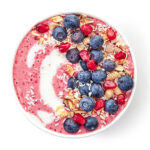Whole Foods Tuna Salad is a delightful and nutritious dish that blends tender tuna with fresh vegetables, creating a flavorful and satisfying meal. Packed with protein, vitamins, and minerals, this salad offers a balanced and wholesome option for those looking for a quick and healthy bite.
| Ingredients: | |
| 1 | 2 drained cans tuna (packed in water) |
| 2 | 1 cup mixed greens (lettuce, spinach, arugula, etc.), washed and chopped |
| 3 | 1/2 cucumber, diced |
| 4 | 1/2 red bell pepper, diced |
| 5 | 1/4 red onion, finely chopped |
| 6 | 2 hard-boiled eggs, peeled and chopped |
| 7 | 1/4 cup Kalamata olives, pitted and sliced |
| 8 | 2 tablespoons capers |
| 9 | Fresh herbs (such as parsley or dill), chopped (optional) |
| 10 | Salt and pepper to taste |
| # | For the Dressing: |
| 11 | 3 tablespoons extra virgin olive oil |
| 12 | 2 tablespoons lemon juice |
| 13 | 1 teaspoon Dijon mustard |
| 14 | Salt and pepper to taste |
Step-by-step cooking instruction of Whole foods tuna salad:
Step-1 In a large bowl, combine the drained tuna, chopped mixed greens, diced cucumber, diced red bell pepper, finely chopped red onion, chopped hard-boiled eggs, sliced olives, and capers.
Step-2 If using fresh herbs, add them to the bowl as well.
Step-3 In a separate small mixing bowl, add the olive oil, lemon juice, Dijon mustard, salt, and pepper.
Step-4 Dress the tuna and veggie mixture with the dressing. Gently toss everything together to ensure all ingredients are coated with the dressing.
Step-5 Taste and adjust the seasoning with more salt and pepper if needed.
Step-6 Serve the Whole Foods Tuna Salad immediately as a standalone dish or on a bed of additional mixed greens. It can also be enjoyed in a sandwich, wrap, or as a topping for whole grain crackers.
Nutritional values of Whole foods tuna salad:
Nutrition Information for Whole Foods Tuna Salad (per serving, approximately):
| 1 | Calories: 300-350 kcal |
| 2 | Protein: 25-30g |
| 3 | Carbohydrates: 10-15g |
| 4 | Dietary Fiber: 2-4g |
| 5 | Sugars: 3-5g |
| 6 | Fat: 18-22g |
| 7 | Saturated Fat: 3-5g |
| 8 | Omega-3 Fatty Acids: About 500-1000mg |
| 9 | Cholesterol: 150-200mg |
| 10 | Sodium: 600-800mg |
| 11 | Vitamins and Minerals: The salad is rich in various vitamins and minerals, including Vitamin A, Vitamin C, Vitamin K, Folate, Potassium, Iron, and Calcium, among others. |
Background History of Whole foods tuna salad:
Whole Foods Market:
Whole Foods Market is a well-known American supermarket chain specializing in natural and organic foods. It was founded in 1980 in Austin, Texas, by John Mackey, Renee Lawson Hardy, Craig Weller, and Mark Skiles.
The company’s emphasis on providing high-quality, natural, and organic products has been a central part of its identity since its inception.
Over the years, Whole Foods Market has become synonymous with a variety of fresh and healthy food offerings, including salads, prepared foods, and deli items.
Tuna Salad:
Tuna salad is a classic dish made from canned tuna fish mixed with various ingredients such as vegetables, herbs, and dressings.
The exact origin of tuna salad is not well-documented, but it became popular in the United States in the mid-20th century as canned tuna became widely available and convenient.
Tuna salad recipes have evolved over time, with different variations and ingredients being used based on regional and personal preferences.
If “Whole Foods Tuna Salad” refers to a specific recipe or dish that has been popularized or offered by Whole Foods Market, that information might be more recent and not within my knowledge cutoff date. To learn more about the specific background history of “Whole Foods Tuna Salad,” I recommend reaching out to Whole Foods Market directly or checking their official resources for any relevant updates or information about their prepared foods offerings.
| Advantages of Whole foods tuna salad | |
| 1 | Nutrient-Rich: Whole Foods Tuna Salad is typically packed with nutrient-rich ingredients like tuna, mixed greens, vegetables, and herbs, providing a variety of vitamins, minerals, and antioxidants. |
| 2 | Protein Source: Tuna is a high-quality source of lean protein, essential for muscle repair, immune function, and overall health. |
| 3 | Omega-3 Fatty Acids: Tuna is rich in omega-3 fatty acids, which have been associated with various health benefits, including heart health and brain function. |
| 4 | Vegetable Intake: The salad includes a mix of vegetables like cucumber, bell pepper, and mixed greens, contributing to your daily vegetable intake and providing fiber. |
| 5 | Convenience: Whole Foods Tuna Salad is often available as a convenient and quick option for those on-the-go or looking for an easy meal. |
| 6 | Customizable: You can adjust the ingredients to suit your preferences and dietary needs, adding or omitting elements as desired. |
| 7 | Light and Satisfying: It offers a light yet satisfying meal option, suitable for those seeking a lower-calorie meal without compromising taste. |
| Disadvantages of Whole foods tuna salad | |
| 1 | Sodium Content: Depending on the type of tuna used and any added condiments, the salad can have a relatively high sodium content, which may be a concern for individuals with hypertension or those watching their sodium intake. |
| 2 | Mercury Concerns: Tuna, especially certain types like albacore, can contain mercury, which may pose a risk if consumed in excessive amounts, particularly for pregnant women and young children. |
| 3 | Allergens: Tuna salad can contain allergens like fish, eggs, and tree nuts (if included), which can be problematic for individuals with allergies. |
| 4 | Caloric Intake: Depending on the portion size and added ingredients (such as dressing and additional toppings), the salad’s calorie content may be higher than expected. |
| 5 | Dressing Choices: While dressings can enhance flavor, some dressings may add extra calories, sugars, or unhealthy fats. Opting for a healthier dressing can mitigate this. |
| 6 | Cost: Pre-made or store-bought versions of Whole Foods Tuna Salad might be more expensive than making it at home due to the use of premium ingredients. |
| 7 | Environmental Impact: Tuna fishing practices can have environmental implications, including overfishing and bycatch, which could raise concerns for sustainable seafood choices. |
Compare with Similar meal of Whole foods tuna salad:
If you’re looking for meal options similar to Whole Foods Tuna Salad in terms of being healthy, balanced, and flavorful, there are several alternatives you might consider. Here are a few ideas:
| 1 | Grilled Chicken Salad: A salad featuring grilled chicken breast, mixed greens, a variety of vegetables, and a light vinaigrette. This provides lean protein and plenty of fresh produce. |
| 2 | Quinoa and Vegetable Salad: A salad made with cooked quinoa, colorful vegetables, fresh herbs, and a lemon or balsamic vinaigrette. Quinoa is a complete protein source. |
| 3 | Greek Salad: A Mediterranean-inspired salad with tomatoes, cucumbers, red onion, Kalamata olives, and feta cheese, drizzled with olive oil and lemon juice. |
| 4 | Salmon Salad: Similar to tuna salad but with cooked salmon, mixed greens, and a citrus or dill dressing. Salmon is rich in omega-3 fatty acids. |
| 5 | Chickpea Salad: A plant-based option featuring chickpeas, diced vegetables, fresh herbs, and a tahini-based dressing. Chickpeas provide protein and fiber. |
| 6 | Shrimp and Avocado Salad: A combination of cooked shrimp, avocado, cherry tomatoes, red onion, and lime-cilantro dressing. |
| 7 | Bean and Vegetable Salad: A mix of your favorite beans (such as black beans, kidney beans, or white beans) with chopped vegetables, herbs, and a simple vinaigrette. |
| 8 | Tofu and Vegetable Salad: Cubes of tofu marinated and grilled, served with a variety of fresh vegetables and a sesame-ginger dressing. |
| 9 | Egg Salad: A classic egg salad made with hard-boiled eggs, mayonnaise or Greek yogurt, mustard, and finely chopped vegetables or herbs. |
| 10 | Roasted Vegetable Salad: A warm salad featuring roasted vegetables like sweet potatoes, bell peppers, zucchini, and red onion, tossed with olive oil and your choice of seasonings. |
Mostly questions asked about Whole foods tuna salad
1: Is Whole Foods Tuna Salad healthy?
A: Yes, Whole Foods Tuna Salad can be a healthy option as it typically includes lean protein, vegetables, and healthy fats. However, the nutritional content depends on the specific recipe and portion size.
2: What ingredients are in Whole Foods Tuna Salad?
A: Whole Foods Tuna Salad typically includes tuna, mixed greens, vegetables (like cucumber, bell pepper, etc.), and a dressing. Additional ingredients can vary.
3: Is Whole Foods Tuna Salad gluten-free?
A: It can be gluten-free, depending on the ingredients and dressing used. Make sure to choose gluten-free options if needed.
4: Can I make Whole Foods Tuna Salad at home?
A: Absolutely! Whole Foods Tuna Salad is easy to recreate at home using canned tuna, fresh vegetables, and a homemade dressing.
5: What dressing is used in Whole Foods Tuna Salad?
A: The dressing can vary but often includes options like olive oil, lemon juice, balsamic vinegar, or light vinaigrette.
6: Is Whole Foods Tuna Salad good for weight loss?
A: Whole Foods Tuna Salad can be part of a weight loss plan due to its protein and nutrient content, but portion control and dressing choices are important.
7: How do I store Whole Foods Tuna Salad leftovers?
A: Refrigerate leftovers in an airtight jar for up to 2-3 days. To keep the salad from turning mushy, keep the dressing separate.
8: Can I add different vegetables to Whole Foods Tuna Salad?
A: Yes, you can customize the salad by adding various vegetables such as carrots, radishes, or even fruits like apples or grapes.
9: Is Whole Foods Tuna Salad suitable for meal prep?
A: Yes, Whole Foods Tuna Salad can be prepared in advance and stored in portioned containers for easy meal prep.
10: Can I use canned salmon instead of tuna in Whole Foods Tuna Salad?
A: Yes, you can substitute canned salmon for tuna to create a salmon salad with a similar concept.







